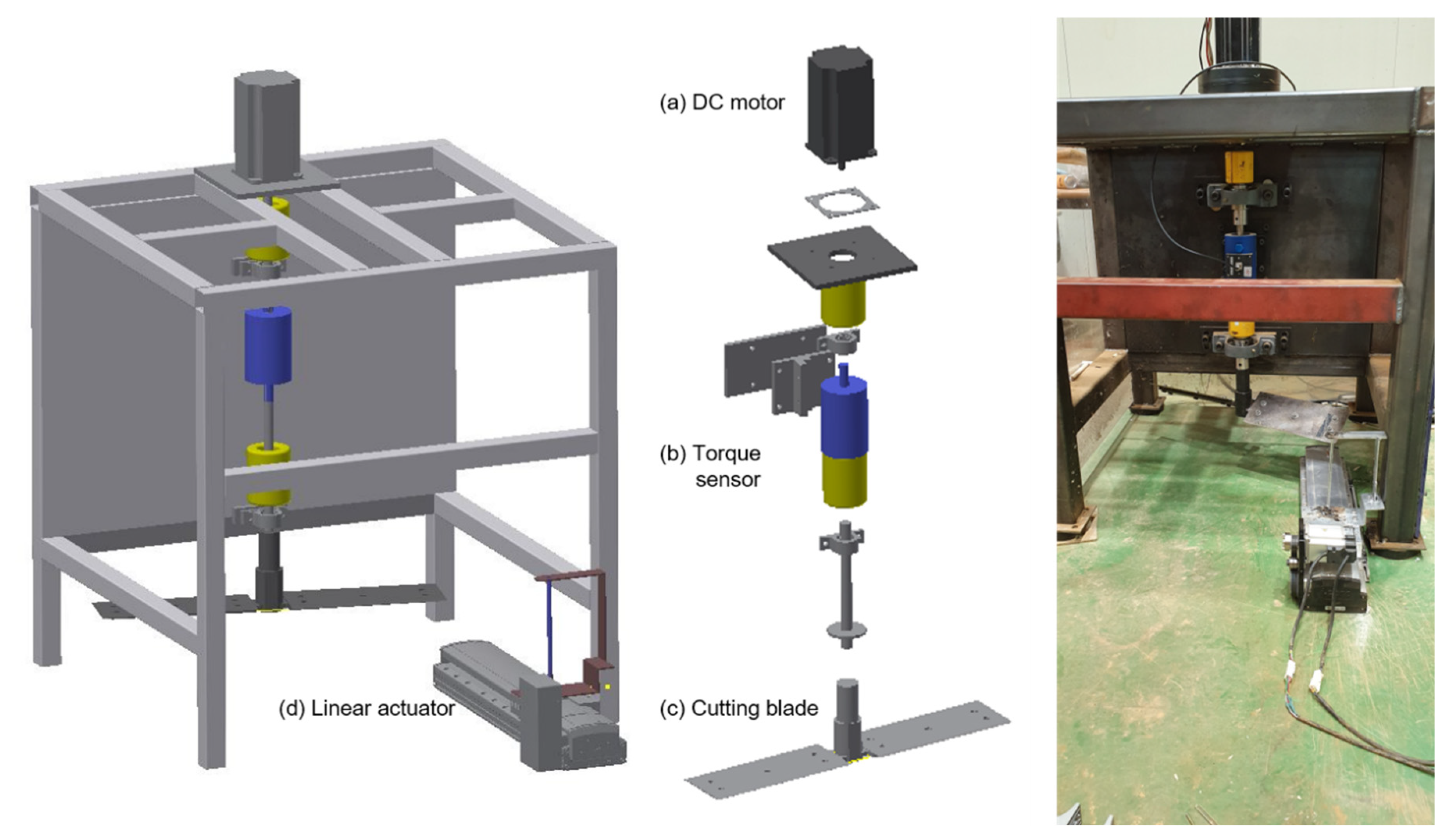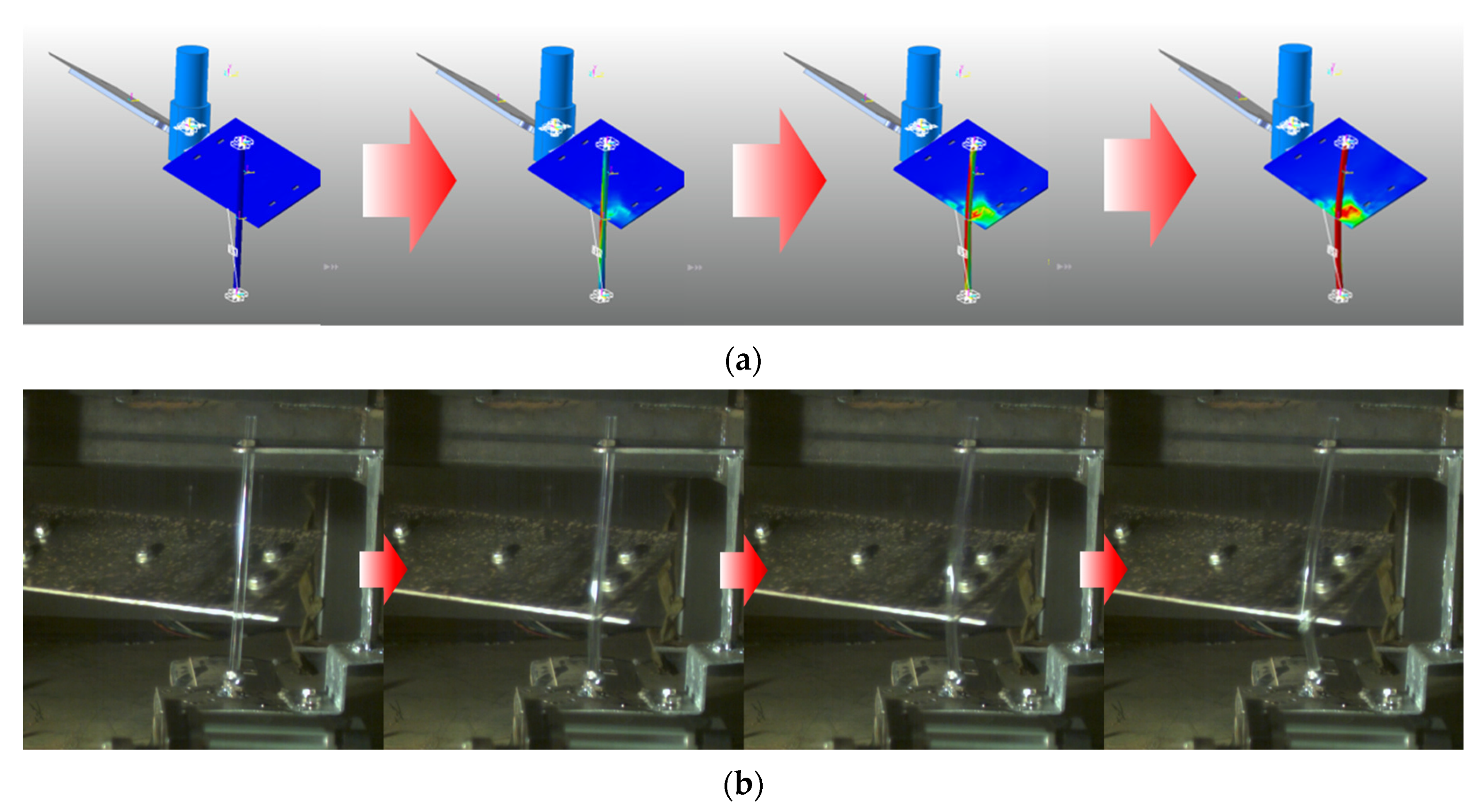Development and Performance Test of a Simulation-Based Tractor-Attachable Wind-Blast-Type Onion Stem Cutting Machine
Abstract
:1. Introduction
2. Materials and Methods
2.1. Stress Analysis on Stem Cutter Blade in Simulation
2.2. Experiment for Stress Analysis with Stem Cutting Test Equipment
2.3. Field Test of Tractor-Attachable Stem Cutting Machine
3. Results and Discussion
3.1. Analysis of Stem Cutter Blade Installation Angle
3.2. Validation with the Tractor-Attachable Wind-Blast-Type Onion Stem Cutting Machine
4. Conclusions
Funding
Data Availability Statement
Conflicts of Interest
References
- Rural Development Administration (RDA). 2019 Agricultural Machinery Usage Survey; RDA: Jeonju, Republic of Korea, 2020. Available online: https://sejong.nl.go.kr/search/searchDetail.do?rec_key=SH1_KMO202121577&upperMenuId=&menuId=&part=&topF1= (accessed on 20 July 2019).
- Korean Society for Agricultural Machinery. Derivation of Mechanization Strategies for Field Farming and Mechanization Strategies for Each Major Crop to Enhance Field Farming Competitiveness; Research report; Ministry of Agriculture, Food and Rural Affairs (MAFRA): Sejong, Republic of Korea, October 2014. Available online: https://scienceon.kisti.re.kr/commons/util/originalView.do?cn=TRKO201800001502&dbt=TRKO&rn= (accessed on 20 July 2019).
- Choi, Y.; Jun, H.J.; Lee, C.K.; Hong, J.T.; Cho, Y.M.; Yoo, S.N.; Kim, J.D. A fundamental study for development of onion harvester. Proc. Korean Soc. Agric. Mach. 2006, 10, 44–48. [Google Scholar]
- Lee, S.Y.; Han, C.W.; Park, H.J.; Kweon, G.Y. A Fundamental study for pre-harvest treatment system with an onion stem cutter and a plastic mulch wrapper. J. Agric. Life Sci. 2018, 52, 151–162. [Google Scholar] [CrossRef]
- Rural Development Administration (RDA). Labor Input Time by Crop and Operation; RDA: Suwon, Republic of Korea, 1999. Available online: https://www.rda.go.kr:2360/board/board.do?boardId=openinfoboard&prgId=opp_openinfoboard&menu_id=opp&currPage=255&dataNo=100000153854&mode=updateCnt#script (accessed on 20 July 2019).
- Tomita, M.; Kawasaki, K.; Honjo, H.; Kanetani, Y. Studies on the mechanical harvest system for onions. Res. Bull. Hokkaido Natl. Agric. Exp. Stn. 1978, 122, 55–85. [Google Scholar]
- Wingate-Hill, R. Performance of a top-lifting harvester for early onions. J. Agric. Eng. Res. 1977, 22, 271–281. [Google Scholar] [CrossRef]
- Maw, B.W.; Smittle, D.A.; Mullinix, B.G. Artificially curing sweet onions. Appl. Eng. Agric. 1977, 13, 517–520. [Google Scholar] [CrossRef]
- Droll, R.W.; Armstrong, R.E.; Coble, C.G.; Alfred, W.H. Mechanical onion top removal and related pre-harvest practices. Trans. ASAE 1976, 19, 1048–1050. [Google Scholar] [CrossRef]
- Kim, D.H.; Yoo, S.N.; Kim, Y.T.; Choi, Y. A fundamental study on roller onion topper. Proc. Korean Soc. Agric. Mach. 2006, 11, 88–94. [Google Scholar]
- Kim, H.J.; Jang, J.H.; Kim, N.K. A study on Interference phenomenon of a machine tool when 5 axis working with virtual machine tool. J. Korean Soc. Manuf. Process. Eng. 2005, 4, 16–23. [Google Scholar]
- Son, H.J.; Cho, Y.T.; Jung, Y.G. The development of module for 5-axis drilling of a closed type impeller. J. Korean Soc. Manuf. Process. Eng. 2014, 13, 1–7. [Google Scholar]
- Jung, H.C.; Hwang, J.D.; Jung, Y.G. Development of CAM automation module (E-ICAM) for 5-axis machining of impeller: A study on configuration of module. J. Korean Soc. Manuf. Process. Eng. 2011, 10, 109–114. [Google Scholar]
- Rural Development Administration. Available online: http://www.nongsaro.go.kr/portal/ps/psb/psbk/kidofcomdtyDtl.ps?pageIndex=1&pageSize=10&menuId=PS00067&sText=&sStdPrdlstCode=VC041201&sStdTchnlgyCode=GC07&sRdaStdPrdlstCode=VC&sRdaStdTchnlgyCode=&kidofcomdtyNo=28412&sOldDtShowAt=N&sKeyword=&sNameOrderAt=Y&sSearchText=&sSearchTextM= (accessed on 20 July 2019).






| Material Property | Steel | Acrylic Rod |
|---|---|---|
| Density (kg/mm3) | 7.85 × 10−6 | 1.18 × 10−6 |
| Young’s modulus (N/mm2) | 200,000 | 3200 |
| Poisson’s ratio | 0.285 | 0.394 |
| Installation Angle (°) | Torque Measured Value of Simulation Analysis (N·mm) | Torque Measured Value of Stem Cutting Test Equipment (N·mm) |
|---|---|---|
| 0 | 930.92 | 1026.49 |
| 10 | 837.63 | 918.88 |
| 20 | 633.89 | 670.15 |
| 30 | 553.80 | 574.02 |
| 40 | 495.45 | 485.97 |
| Installation Angle (°) | Motor Power Consumption (Wh) |
|---|---|
| 0 | 44.28 |
| 10 | 53.60 |
| 20 | 64.94 |
| 30 | 91.90 |
| 40 | 172.48 |
| Installation Angle (°) | Wind Velocity (m/s) |
|---|---|
| 0 | 0 |
| 10 | 0.39 |
| 20 | 0.44 |
| 30 | 0.75 |
| 40 | 0.98 |
| Moisture Content | 0° | 10° | 20° | 30° | 40° |
|---|---|---|---|---|---|
| 60% | not cut | not cut | partly cut | cut | cut |
| 80% | not cut | not cut | not cut | cut | cut |
| Experiment | 1st | 2nd | 3rd | Total | ||
|---|---|---|---|---|---|---|
| Tractor traveling speed (m/s) | 0.4 | Mean (cm) | 10.81 | 8.65 | 10.48 | 9.98 |
| S. D. (cm) | 4.16 | 3.95 | 5.68 | 4.72 | ||
| Cutting rate (%) | 96.2 | 98.1 | 96.1 | 96.8 | ||
| 0.6 | Mean (cm) | 10.98 | 9.25 | 9.01 | 9.75 | |
| S. D. (cm) | 4.67 | 4.29 | 4.55 | 4.56 | ||
| Cutting rate (%) | 94.1 | 98.1 | 96.2 | 96.1 | ||
| 0.8 | Mean (cm) | 16.27 | 11.22 | 11.56 | 13.03 | |
| S. D. (cm) | 14.70 | 8.94 | 7.37 | 11.00 | ||
| Cutting rate (%) | 79.2 | 92.2 | 90.6 | 87.3 | ||
Disclaimer/Publisher’s Note: The statements, opinions and data contained in all publications are solely those of the individual author(s) and contributor(s) and not of MDPI and/or the editor(s). MDPI and/or the editor(s) disclaim responsibility for any injury to people or property resulting from any ideas, methods, instructions or products referred to in the content. |
© 2023 by the author. Licensee MDPI, Basel, Switzerland. This article is an open access article distributed under the terms and conditions of the Creative Commons Attribution (CC BY) license (https://creativecommons.org/licenses/by/4.0/).
Share and Cite
Lee, S. Development and Performance Test of a Simulation-Based Tractor-Attachable Wind-Blast-Type Onion Stem Cutting Machine. Machines 2023, 11, 508. https://doi.org/10.3390/machines11050508
Lee S. Development and Performance Test of a Simulation-Based Tractor-Attachable Wind-Blast-Type Onion Stem Cutting Machine. Machines. 2023; 11(5):508. https://doi.org/10.3390/machines11050508
Chicago/Turabian StyleLee, Sangyoon. 2023. "Development and Performance Test of a Simulation-Based Tractor-Attachable Wind-Blast-Type Onion Stem Cutting Machine" Machines 11, no. 5: 508. https://doi.org/10.3390/machines11050508
APA StyleLee, S. (2023). Development and Performance Test of a Simulation-Based Tractor-Attachable Wind-Blast-Type Onion Stem Cutting Machine. Machines, 11(5), 508. https://doi.org/10.3390/machines11050508





